A Report to the Minister for Justice, 30 November 1992.
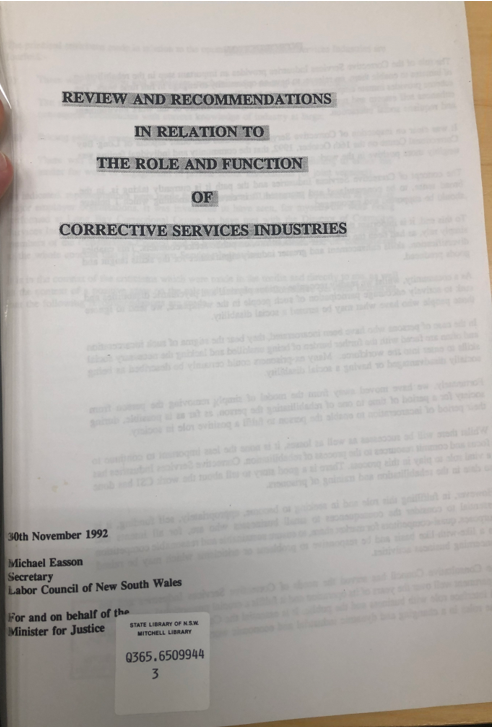
Introduction
The role of the Corrective Services Industries provides an important step in the rehabilitation of inmates to enable them, on release, to have an opportunity to engage in full time work. The scheme provides inmate employees with access to skills which will be marketable to industry, enhances self-esteem and provides an understanding of the nature of the work environment and requisite social interaction.
It was clear on inspection of Corrective Services Industries (CIS) and other aspects of Long Bay Correctional Centre on the 16th October 1992, that the community and individual feeling was tangibly more positive in the work areas, as opposed to the prison proper.
The concept of Corrective Services Industries and the path it is currently taking is, in the broad sense, to be congratulated and promoted. It is certainly something which I believe should be supported and encouraged.
To this end, it is important that the CSI continue to operate in the market at large and not simply rely, as had been the case some years before, on public sector contracts. This enables diversification, skills enhancement and greater industry significance for the skills taught and goods produced.
As a community, whilst we readily recognise various physical and psychiatric disabilities and seek to actively encourage participation of such people in the workplace, we tend to ignore those people who have what may be termed a social disability.
In the case of persons who have been incarcerated, they bear the stigma of such incarceration and often are faced with the further burden of being unskilled and lacking the necessary social skills to enter into the workforce. Many ex-prisoners could certainly be described as being socially disadvantaged or having a social disability.
Fortunately, we have moved away from the model of simply removing the person from society for a period of time to one of rehabilitating the person, as far as is possible, during their period of incarceration to enable the person to fulfil a positive role in society.
Whilst there will be successes as well as losses, it is none the less important to continue to focus and commit resources to the process of rehabilitation. Corrective Services Industries has a vital role to play in this process. There is a good story to tell about the work CSI has done to date in the rehabilitation and training of prisoners.
However, in fulfilling this role and in seeking to become, appropriately, self-funding, it is essential to consider the consequences to small businesses who, for all intents and purposes, are quasi-competitors for market share, to ensure sustainable and reasonable competition on a like-with-like basis and be responsive to problems or criticisms which may be raised concerning business activities.
The Consultative Council has served the needs of Corrective Services Industries and the Department well over the years of its operation, and it fulfils a crucial promotional, monitoring and interface role with business and the public. It is essential the Consultative Council fulfil those roles in a changing and dynamic industrial and economic world.
The principal criticisms made in relation to the operation of Corrective Services Industries are fourfold: (i) There was no precise and consistent mechanism for dealing with complaints; (ii) The membership of the existing Consultative Council is not freshly renewed, with consequent deficiencies with current knowledge of industry at large; (iii) Pricing policies create an unfair market advantage; and (iv) There was no perceived or actual precise or fair mechanism relating to either the tender for work or engagement in private sector associations [or joint ventures].
As indicated, representations were made from a number of unions and businesses as well as major employer organisations. It was invaluable to have seen, for myself, the work being performed at Long Bay Correctional Centre, to have met with the Director of Corrective Services Industries, the Commissioner and Deputy Commissioner of Corrective Services and members of the Consultative Council and to have seen the enthusiasm and the commitment to the whole concept that is Corrective Services Industries.
It is in the context of the criticisms, which were made in the media and directly to me, as well as the context of a positive view on the role and function of Corrective Services Industries, that the following recommendations are made.
Recommendations
1. Consultative Council
1. Membership
It is recommended that the Consultative Council, appointed by the Minister for Justice, should comprise: (i) 2 employer representatives of which 1 representative is nominated by the Chamber of Manufactures of New South Wales and 1 representative is nominated by the Metal Trades Industry Association of Australia; (ii) 2 employee representatives nominated by the Labor Council of New South Wales; (iii) 1 Community representative selected from nominees following appropriate advertisement of the position in the Sydney Morning Herald; (iv) 1 TAFE or adult education representative; and (v) The Director of Corrective Services Industries.
2. Term of Appointment
With the exception of the Director of Corrective Services Industries, it is recommended that the members of the Consultative Council be appointed for a term of two years with the possibility of a further appointment for a second term of 2 years, giving a maximum participation period of 4 years.
Consideration might also be given to staggering appointments so that not every member is up for appointment at the same time.
3. Qualifications of Appointment
All appointees should have a demonstrable commitment to the concept of Corrective Services Industries and seek to promote the concept and further the success of the business.
With respect to prospective employer and employee appointees, it is necessary that they have an extensive understanding of and experience in industry, current knowledge of industry and related industrial issues and an understanding of the likely impact, if any, of market decisions made by the Corrective Service Industries.
4. Chairperson
It is recommended that the position of Chairperson of the Committee be, appointed from the employer and employee representatives for a term of two years on an alternating basis.
5. Frequency of Meetings
To ensure that matters which may arise can be dealt with as expeditiously and thoroughly as possible, it is recommended that the Consultative Committee meet every second month, or as otherwise required.
6. Immediate Issues
It is recommended that fresh nominations are called for and a new Consultative Committee is appointed from January 1993, to ensure that criticisms, valid or otherwise, which have been made are seen to have been dealt with and to assist in the creation of a positive environment in which the work of Corrective Services Industries can continue.
2. Role of the Consultative Council and Reporting Mechanisms
Whilst the designated role of the Consultative Council is sufficient, prima facie, to ensure a harmonious relationship with general industry sectors whilst maintaining a positive and growing commitment to correctional developments, there are basic shortcomings in actual assessment, reporting and practical grievance handling.
It is therefore recommended that: (i) The primary reporting responsibility and accountability be, as is currently the case, to the minister; (ii) The Council ordinarily provide a full report of activities quarterly, to the minister and interested organisations including the Labor Council of New South Wales, the Chamber of Manufactures NSW and the Metal Trades Industry Association; (iii) The primary role of the Consultative Council should continue to be to review the operations of the Corrective Services Industry, scrutinise forward business development plans and generic contract opportunities with an annual value of $10 000 or more and review operations through corporate marketing, sales and financial reports and promote the continued importance of the business; (iv) Should an issue arise, in relation to the expansion of a current business activity or proposed business activity, which will significantly or which is reasonably likely to significantly impact upon existing private sector enterprises, the Consultative Council, through the Department of Collective Services, shall take the necessary steps to inform the relevant business or employer and union organisations of the proposal and shall consider submissions which may be put to them in respect to the negative impact on business, prior to extending such business enterprise or engaging in a new enterprise; (v) Should a matter be referred to the Consultative Council directly or through the Department or Corrective Services Industries which concerns a complaint about the operation any Corrective Services Industries operation, the grievance handling process [as recommended hereunder at Recommendation No. 4] shall be followed; (vi) The Consultative Council should be fully informed of any business proposals, including joint ventures with the private sector, and such information should include, but not be limited to, relevant private industry pricing information, proposed product pricing, proposed or actual production volumes, location of the proposed business and local business undertakings which produce similar goods or components; (vii) The Consultative Council shall review proposed business opportunities or expansions and make recommendations as to the efficacy or otherwise of the proposal.
3. Product Pricing
The most consistent and persistent complaint in respect to the operation of Corrective Services Industries was in relation to unreasonable market advantage achieved through greatly reduced product pricing. These complaints are borne out by examples of industry product prices provided in Appendix A.
It would seem that more stringent attention is required to factoring in all appropriate on-costs and to have regard to usual industry mark-up arrangements. It is therefore recommended that either:-
i. Unit or service pricing adopt normal costs and on-costs associated with manufacture in general industry of the particular item or the provision of the particular service. Such items would include, but not be limited to, award costs, Workers’ Compensation, insurance, payroll tax, tooling up costs, cost of materials, depreciation, company tax, marketing, transport costs and the Training Guarantee Levy; or
ii. Unit or service pricing include all matters relevant to the production in the correctional environment Such factors would include the cost of labour, inmate upkeep expenses, cost of supervision, tooling up and equipment depreciation values, training costs, cost of materials, marketing costs and any other item which directly or indirectly related to the cost of labour and so forth in the circumstances. It may also be relevant to factor in, nominally, other costs such as Workers’ Compensation; and,
iii. Price monitoring occur through the auspices of the Consultative Council to ensure that pricing structures relate as closely as possible to the private sector, such that there is real competition and not unreasonable price discounting.
4. Grievance Process
Whilst the there is an in-house, understood method of dealing with complaints related to the operation of Corrective Services Industries, it would appear to be an insufficient mechanism for dealing adequately and quickly with issues raised by complainants.
Therefore it is recommended that:-
i. A procedure be developed for dealing with complaints raised in relation to the operation of Corrective Services Industries operations.
ii. That this process be clearly detailed in the “Community Awareness Kit” or other literature provided to business, unions and community groups.
iii. Complaints should be referred through the Director of Corrective Services Industries to the Consultative Council.
iv. An appeal process should lie to the Director General of Corrective Services and the minister.
It is recommended that such procedures encompass:
(i) Referral and direction of all complaints to the Director of Corrective Services Industries for consideration and response;
(ii) Contacting the complainant with a view to meeting with the complainant and their representatives, the Director of Corrective Services Industries and the chairperson of the Consultative Council, if the matter can not be resolved by telephone or letter,
(iii) Examination of the basis of the complaint and review of documentation which may be proffered in support of the complainant;
(iv) Referral of the matter to the full Consultative Committee for consideration;
(v) Notification of any decision taken in respect of the complaint with supporting documentation to the complainant;
(vi) Expeditious handling of substantive complaints; and
(vii) Notification to the minister of the nature of the complaint and the action undertaken.
5. Joint Ventures and Business Undertakings
1. Private Sector Associations
With respect to private sector associations with Corrective Services Industries, which may be termed joint ventures, it is acknowledged that both parties benefit from such association in respect to skills enhancement, labour costs, capital outlays and so forth. However, it is essential that such associations are entered into under proper contractual arrangements and through scrupulous tendering processes.
It is recommended that:
(i) A standard form of government tendering process be utilised to invite private sector participation in business undertakings, in circumstances agreed by the Consultative Council;
(ii) That a standard Departmentally approved form of minor and major contract be utilised;
(iii) That any contract or contracts with a company, for an overall value of more than
$10 000 per annum, be scrutinised by the Consultative Council prior to being entered into and that their recommendations be referred to the minister;
a. That a contract be entered into for a fixed commercially viable period of 12 months with a 12 month option, after which tenders must again be called;
b. That care be taken when such arrangements are entered into, especially in regional centres, that true market competitiveness will occur and that the joint venture party is unlikely to unfairly monopolise the available market;
c. Monitoring occur, through the Consultative Council, of market impact or problems which may come to light and which are attributable to the impact of an endorsed business or undertaking; and
d. The extent of such contracts be in respect to either import replacement or whole unit manufacture where imported components are utilised or refurbishment and repair operations.
2. Contacting and Tendering for Business
i. It is recommended that Corrective Services Industries should tender for work, where such work is to be allocated by a tender process, on the same basis as private sector ‘competitors’. Such process should also apply to work to be undertaken for and on behalf of the public sector.
ii. The public sector standards should apply with respect to the value of minor and major contract values, with major contracts to be scrutinised by the Consultative Council prior to commencement
iii. Normal Departmental procedures should apply with respect to contracts entered into by Corrective Services Industries.
3. Distribution of Products and Services
Where Corrective Services Industries is seeking to distribute goods or services manufactured or provided by one of its business enterprises, not associated with a joint venture arrangement where distribution occurs through the private partner, ideally, it is appropriate to enable the market at large to avail itself of such goods or services.
Where because of the volume of trade, it would not be viable to distribute generally, the availability of such products or services should be advised through the Sydney Morning Herald or other appropriate paper and the supply provided on contract.
It is recommended that such contracts for supply be for a period of 12 months, with an option to extend for a further 12 months.
4. Regional Considerations.
Irrespective of where a Correctional Services Industries operation is undertaken, from time to time, there will be the perception in some sectors of the business community of unfair competition created by the presence of such an undertaking. This is particularly so in a depressed economy.
In view of such perceptions and the reality or otherwise of effects on small business in particular, it is recommended:
i. Consideration be given to local economies of scale, local manufacturing participants, their product base and available market catchment area at the time when a business, undertaking or enterprise is to be established under the auspices of the Correctional Services Industries
ii. That where there is a likelihood of competition with local firms or companies, that the information be considered and fully assessed by the Consultative Council; and
iii. That local ‘competitor’ firms and companies be appraised of the proposed operations and any concerns be considered prior to commencement of the proposed undertaking.
5. Post Correctional Employment Opportunities
There is clearly a commitment to ensure that business undertakings entered into are such that general employment opportunities will be available, that inmates gain general employee social skills, as well as ensuring a financial return to Correctional Services Industries, with the stated goal of being self-funding by 2001/2002.
Therefore, it is recommended that the focus on future viable industry sectors and skills bases be retained and in particular that the focus be on:
i) dominant and growing industry sectors, where there is already a high degree of competition and market competitiveness; or
ii) emerging industries where there is a high degree of reliance on imported components or whole sector units and the focus is on such imported materials and not local inputs.
6. Pursuit of Australian Standards and Best Practice
It is appropriate both for the future of Corrective Services Industries as a market player and for the future general employment of inmate employees, that current standards and practices related to employment and production are employed and that quality of goods and services are maintained.
In view of this it may be appropriate to review the current production and quality standards and stated Australian Standards goals to ensure that they correctly reflect the relevant industry requirements and production position in respect to the current business undertakings of Corrective Services Industries.
6. Inmate Employee Safety and General Conditions
It is clear that consideration has been given to ensuring standards of occupational health and safety.
It is recommended that:
(i) The provisions of the Occupational Health and Safety Act apply in respect of inmates employed in any business, undertaking or enterprise established or endorsed by Corrective Services Industries;
(ii) Appropriate instruction and printed material be given to such persons and their supervisors in respect to safe practices;
(iii) Safety equipment be supplied as necessary and appropriate with the relevant instruction being provided for its use; and,
(iv) The various occupational health and safety standards and guidelines which have been developed [and applied in industry generally] in respect to the use of certain chemicals, equipment and material, be applied in respect to any business, undertaking or enterprise established or endorsed by Corrective Services Industry.
7. Educational Standards
(i) It is recommended that skills, relevant to the undertaking of any business undertaking be taught to inmate employees through TAFE or by persons accredited by TAFE to teach the relevant skills components.
(ii) Education and training, provided through association with the business undertakings during the Correctional term, should be such that it provides a TAFE award or is sufficient to articulate with a TAFE award should an inmate employee enter the general workforce prior to completion of correctional training.
(iii) Education and training should take into account best practice philosophies and other relevant industry matters to ensure the best possible opportunity is afforded inmates to be able to secure employment at the completion of their correctional term.
(iv) Business undertakings should be entered into with a view to their future industry relevance in respect to the ongoing value of skills which may be taught and developed.
8. Public Relations
The concept of Prison Services Industries seems to suffer for want of a positive image and the support of the business community.
It is therefore recommended that a greater emphasis be placed on securing general support and understanding of the value of Corrective Services Industries.
This may be done in a number of ways, such as by inviting companies and the relevant unions and the community [particularly in regional centres] to inspect the work undertaken in the various enterprises, to invite discussion and educate and reassure people of the positive benefits of such activity.
In respect to the particular concerns of the private sector, accurate researched information should be provided, in relation to product share, markets and impact on the relevant private sector manufacturers and precise methods and inputs for unit pricing of goods produced by or under the auspices of Corrective Services Industries.
External Representations
Chamber of Manufactures of New South Wales
Metal Trades Industry Association of Australia
NSW Guild of Furniture Manufacturers Ltd,
ADC Computer Cables and Components Australia
Bradley Washfountain Co. (Aust)
The Surry Furniture Company
Sebel Furniture Limited
K.A. Tweedy Pty. Ltd.
Upper Hunter Trades and Labor Council
Australian Workers’ Union
Clothing Textile and Allied Trades Union
Vehicle Builders Employees’ Federation (NSW Branch)
Public Service Association NSW
Metals & Engineering Workers’ Union
Appendix A: Price Comparisons, Corrective Services Industries & the Private Sector
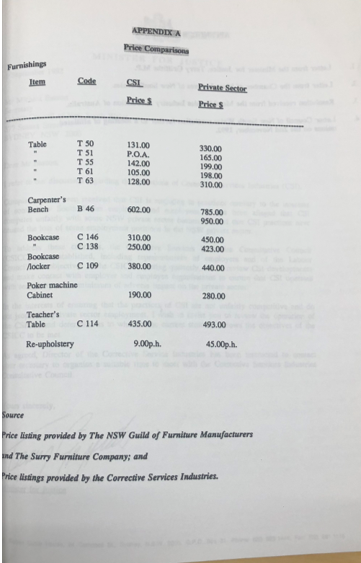
Appendix B: Letters & Submissions
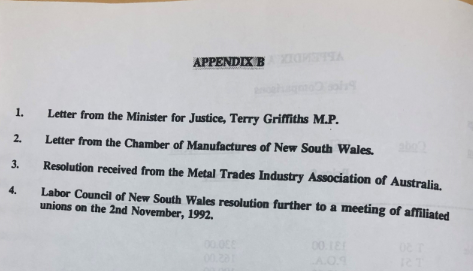
Appendix B1: Commissioning the Review
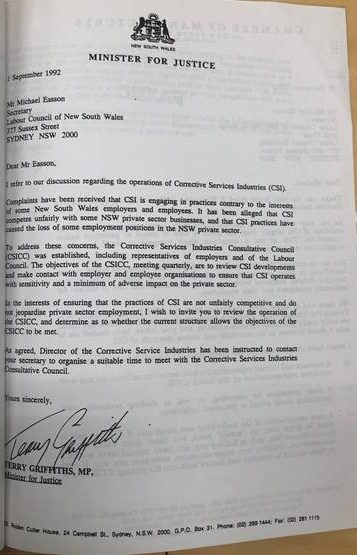
Appendix B2: Letter from the NSW Chamber of Manufactures
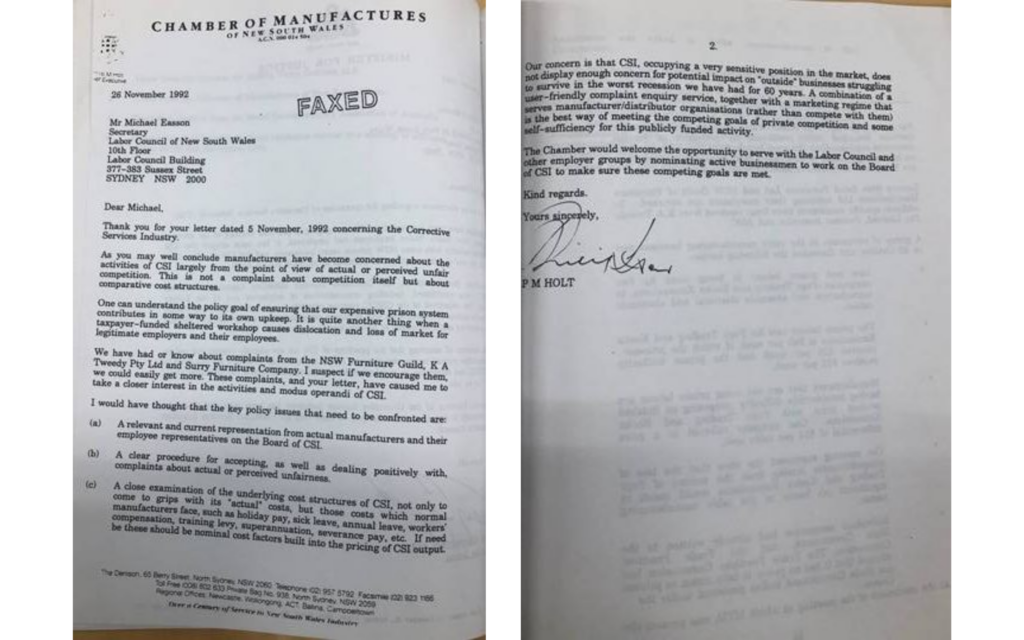
Appendix B.3: Submission from the Metal Trades Industry Association
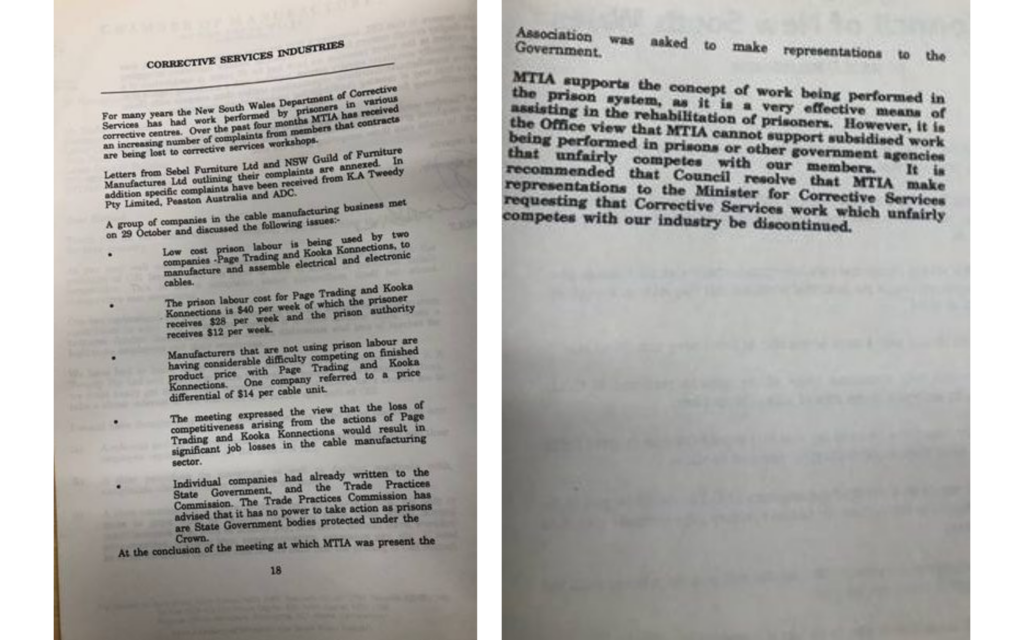
Labor Council Resolution (November 1992)

Postscript (2015)
Sometime in 1992 NSW Premier Nick Greiner telephoned me at the Labor Council of NSW to ask that I consider investigating and then writing a report on prison labour, rehabilitation, and training. Terry Griffith, the then Minister for Corrective Services formally asked in early September 1991 that I examine the operations of the NSW Corrective Services Industries (CSI) and government policy generally. I requested my colleague Gail Gregory, then an Industrial Officer at the Labor Council, to assist. A good deal of the draft Report is informed by her insights and research.
I was concerned that the unions strike a sympathetic perspective on the issues. There had been some complaints from the Clothing Trades Union. Kevin Boyd, the NSW Secretary of that union, once quipped at a Labor Council meeting that the only sure way to be safe in a job in the industry was to be locked up at Long Bay.
The review required meeting with potential complainants, listening, learning about the work done and the skills development encouraged by CSI, obtaining submissions and representations, and striking the right balance. Also important was ensuring that the end result was practical without too much complexity and paper generation along the way. A description of my review and calls for submissions were publicly invited by advertisement. I met with industry bodies and specific organisations and companies to hear their views. No one wanted to read long, technical submissions, or to encourage them. But, of course, anyone interested had the opportunity to submit their view at whatever length they liked.
Quickly I learnt that most people on the wrong side of iron bars were atrociously educated, some barely at all, many experienced drug addiction, a large number were in some way mentally defective, and there was a huge aboriginal population, at least ten times the representation in the general population. All were in prison because they had been sent there by a Court, with evidence presented, sometimes contested, and ultimately a sentence imposed. In public life, I saw no sign of any contemporary political leader who deliberatively delved into the question of prison reform, preoccupied with an Australian version of a Panopticon prison as, in Jeremy Bentham’s definition, “a mill for grinding rogues honest”.
The minister, understandably, wanted a Report by the end of 1992 that clearly set out what needed to be done in regulating and guiding the CSI. He had little time for “theory”. It was as if there was the hope that particular outbreaks of honesty might happen through hard work and skills development on the inside – and, once released, thereafter a chance to win a job on the outside. Nothing systematic, thoughtful, or nuanced was happening.
On one summer visit to Long Bay, I viewed print-making for t-shirts and a few other labour intensive workshops. Some furniture carpentry was permitted. I cannot say that the highest standard of work skills were being developed, but at least it was something. Away from the workshops in an open yard, a fist fight erupted near where I was touring. The prison guards who were with me the whole time ushered me to safety, as a wild mellee broke out. That experience struck me as indicative that in the hot oppressive environment, that boredom, a sense of complete emptiness and worthlessness must fuel apathy, resentment and, in some, violence.
If you think prisons are only places to slam the cell door shut then forget, then much of the tough talk about lengthy prison sentences appeals. But hopefully most people who go to jail will not end up recidivists. The environment they experience is relevant to that hope.
Prisons ought to be places where skills can be learnt and despite everything, potential employability enhanced. That was the intention behind this, admittedly, dry and clipped of much explanation, report.
“Tough on crime and tough on the causes of crime” – Tony Blair’s 1997 felicitous phrase when Shadow UK Home Secretary – is an approach that calls attention to many areas of crime prevention, why repeat offending takes place, and what can be done. To think about and address those challenges is not some version of bleeding heart sentimentality. The community rightfully expects those people who have committed serious offences to be locked up. If on the inside, however, for the minor and less serious offenders, there is no hope and nothing worthwile happening then, for many, they are in an unbreaking cycle.
The unions – including, to their great credit, the NSW Clothing Trades Union – were generally positive about the Report and its recommendations. They saw the need for training and humanity in the treatment of prisoners.
A year or two after Bob Debus became NSW Minister for Corrective Services in 1995 under Premier Bob Carr, he told me that he would refresh interest in this Report by tabling it at a Commonwealth ministerial meeting. I believe that happened.






